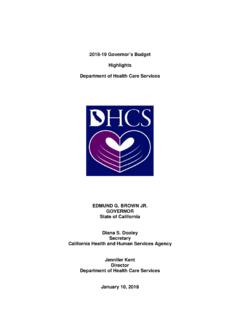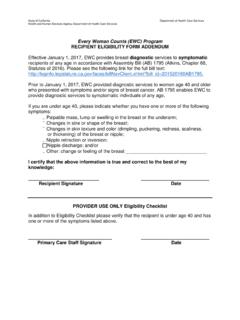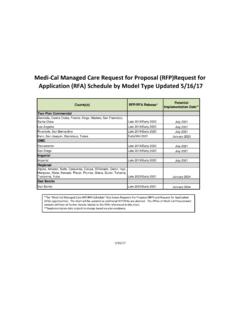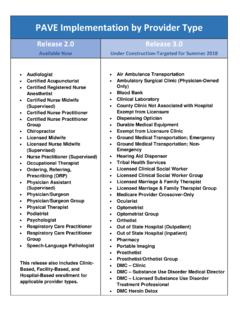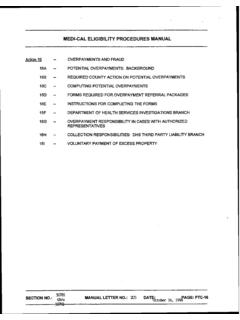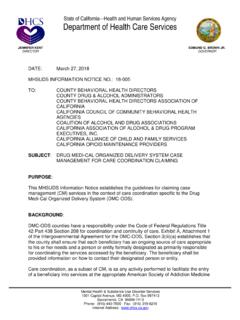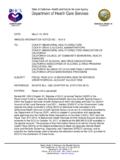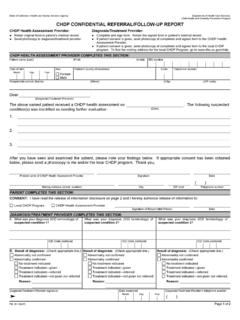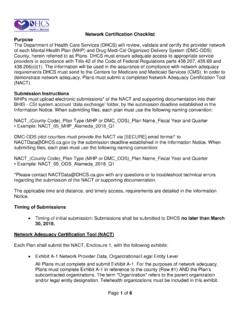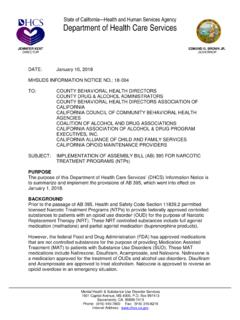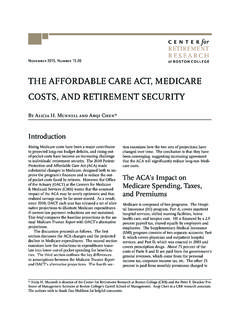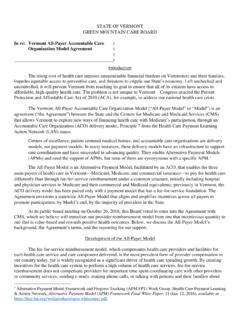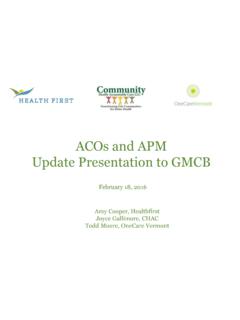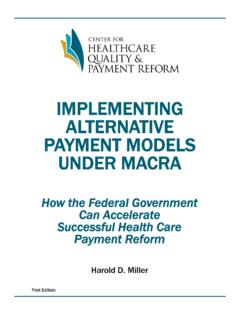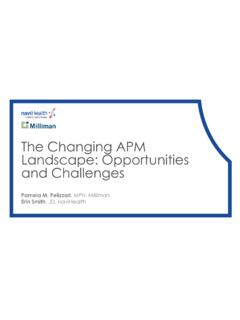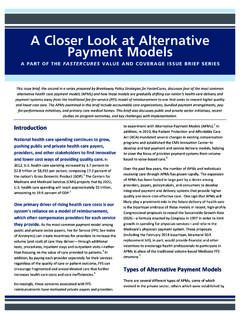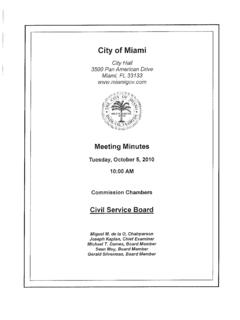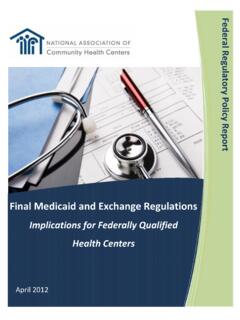Transcription of DHCS Stakeholder Webinar – Medi-Cal 2020 Waiver
1 DHCS Stakeholder Webinar Medi-Cal 2020 Waiver January 25, 2016 Presentation Outline Medi-Cal 2020 Overview Key Programmatic Elements Public Hospital Redesign and Incentives in Medi-Cal (PRIME) Global Payment Program Dental Transformation Initiative Whole Person Care Designated State Health Programs Budget Neutrality Reporting and Evaluation Requirements 2 Medi-Cal 2020 Overview CMS approval for renewal on December 30, 2015 Effective January 1, 2016 through December 31, 2020 $ billion total initial federal funding over 5 years 3 Funding Overview Waiver Programs PRIME GPP* DTI DSHP WPC TOTAL Initial Federal Funding $ $236m** $375m $375m $ $ *GPP funding on this chart does not include the DSH component of the funding.
2 Projecting DSH cuts, DSH funding over the 5 years is estimated to be $ TF / $ FF. **For GPP, initial federal funding only accounts for DY 11 GPP funding as later years may be affected by uncompensated care assessments. 4 Public Hospital Redesign & Incentives in Medi-Cal (PRIME) 5 PRIME: Overview Builds on the success of the Delivery System Reform Incentive Program (DSRIP) that significantly improved care delivery in the Designated Public Hospital (DPH) systems PRIME participating entities will consist of DPHs and District and Municipal Public Hospitals (DMPHs) Incentive payments are earned based on the achievement of specified benchmarks across various metrics In addition, requires the achievement of set targets for moving toward alternative payment methodologies (APM) for DPHs over the course of the Waiver 6 PRIME: Drivers and Purpose Program Purpose.
3 Improve the health of Californians, by advancing improvements in the quality, experience and value of care that DPHs/DMPHs provide Align projects and goals of the PRIME with the other elements of Medi-Cal 2020, avoiding duplication of resources and double payment for program work Develop health care systems that offer increased value for payers and patients Emphasize advances in primary care, cross-system integration, and data analytics 7 PRIME: Public Safety Net Hospital Demographics Designated Public Hospitals District/Municipal Public Hospitals (formerly Non-Designated Public Hospitals) More than 50% of patients served are Medi-Cal or uninsured Provide 30% of all hospital-based care to the Medi-Cal population in the State 17 integrated delivery systems (full spectrum ambulatory/hospital care)
4 21 hospitals Located in urban and suburban areas Academic teaching hospitals Operate more than 1/2 of the State s trauma centers and more than 2/3 of its burn centers Licensed acute beds range approximately from 160 - 600 More than 21% of patients served are Medi-Cal or uninsured and at some locations over 50% Provide 4% of the hospital-based care to the Medi-Cal and uninsured and 20% of care for these populations in rural California 39 district hospitals 1 municipal hospital 28 rural hospitals 20 designated critical access hospitals Licensed acute beds range approximately from 3 - 500 8 PRIME: Funding Annual federal funding available as shown below Non-federal share will be provided by DPHs/DMPHs through IGTs Semi-annual reporting and payment Potential for partial payment for partial achievement DPHs DMPHs DY 11 (Jan 2016 June 2016) $700M $100M DY 12 (July 2016 June 2017) $700M $100M DY 13 (July 2017 June 2018) $700M $100M DY 14 (July 2018 June 2019) $630M $90M DY 15 (July 2019 June 2020) $ $ 5 Year Total $3, $ 9 PRIME: Domain Areas Domain 1: Outpatient Delivery System Transformation Domain 2: Targeted High-Risk or High Cost Populations Domain 3: Resource Utilization Efficiency 10 PRIME: Domain Areas Domain 1.
5 Outpatient Delivery System Transformation Domain Goals Achieve high-quality and efficient, patient-centered care Integrate primary, behavioral health and specialty care Provide appropriate preventive services, early diagnosis and treatment Deliver support for improved self-care Reduce disparities and variation in performance 11 PRIME: Domain Areas Domain 1: Outpatient Delivery System Transformation Projects Integration of Physical and Behavioral Health (required for DPHs) Ambulatory Care Redesign: Primary Care (required for DPHs) Ambulatory Care Redesign: Specialty Care (required for DPHs) Patient Safety in the Ambulatory Setting Million Hearts Initiative Cancer Screening and Follow-up Obesity Prevention and Healthier Foods Initiative 12 PRIME: Domain Areas Domain 2: Targeted High-Risk or High-Cost Populations Domain Goals Enhance quality of life and health outcomes for focus populations that would benefit most significantly from care integration and alignment Reduce avoidable acute care and interventions Improve care transitions 13 PRIME: Domain Areas Domain 2: Targeted High-Risk or High-Cost Populations Projects Improved Perinatal Care (required for DPHs) Care Transitions.
6 Integration of Post-Acute Care (required for DPHs) Complex Care Management for High Risk Medical Populations (Required for DPHs) Integrated Health Home for Foster Children Transition to Integrated Care: Post Incarceration Chronic Non-Malignant Pain Management Comprehensive Advanced Illness Planning and Care 14 PRIME: Domain Areas Domain 3: Resource Utilization Efficiency Domain Goals Decrease unwarranted variation in the use of evidence-based, diagnostics and treatments Avoid overuse and misuse Eliminate the use of ineffective or harmful targeted clinical services 15 PRIME: Domain Areas Domain 3: Resource Utilization Efficiency Projects Antibiotic Stewardship Resource Stewardship: High Cost Imaging Resource Stewardship: Therapies Involving High Cost Pharmaceuticals Resource Stewardship: Blood Products 16 PRIME: APM Requirements A goal of the Waiver is to move participating DPH PRIME providers toward a value-based payment structure when receiving payments for managed care beneficiaries.
7 The Waiver establishes DPH APM targets in the aggregate that, if not met, result in financial penalties. These target percentages are based on the number of Medi-Cal managed care beneficiaries assigned to DPHs where all of, or a portion of, their care is paid for under a contracted APM: 50% by January 2018 (DY 13) 55% by January 2019 (DY 14) 60% by end of Waiver (DY 15) 5% of DPH PRIME funding at risk in DY14 and DY15 is tied to the achievement of the APM targets. 17 APM Payment Types Four ways for payments to be counted towards APM threshold 1) Partial Capitation: Primary care only 2) Partial-plus Capitation: Primary care and some specialty care (varies) 3) Global Capitation: Primary, specialty, ancillary and/or hospital care 4) Additional payment methodologies approved by the State and CMS (set forth in Attachment R) 18 Partial-plus Capitation: Primary care and some specialty care (varies)Global Capitation.
8 Primary, specialty, ancillary and/or hospital careAdditional payment methodologies approved by the State and CMS (set forth in Attachment R) APM Methodology # of unique MCP beneficiaries who choose/are assigned to all PRIME DPHs where MCP-DPH contract requires portion of payment from the MCP to the DPH system is in one of the four accepted APM forms # of unique MCP beneficiaries who choose/are assigned to all PRIME DPH systems in aggregate for the applicable demonstration year APM % for the DY 19 Global Payment Program 20 GPP: Key Goals Improve health of the remaining uninsured through coordination of care Integrate and reform Medicaid DSH and Safety Net Care Pool funding Move away from a cost-based payment methodology restricted to mostly hospital settings to a more risk-based and/or bundled payment structure Encourage public hospital systems to provide greater primary and preventive services, as well as alternative modalities such as phone visits, group visits, telemedicine, and other electronic consultations Emphasize the value of coordinated care and alternative modalities by recognizing the higher value of primary care, ambulatory care, and care management as compared to the higher cost.
9 Avoidable emergency room visits and acute care hospital stays 21 GPP: Methodology Establish statewide pool of funding for the remaining uninsured by combining federal DSH funding for Designated Public Hospitals (DPHs) and some level of federal SNCP funding based on final years of current Waiver Establish individual public hospital system global budgets for remaining uninsured for each DPH from the overall pool based on annual threshold amount determined through baseline analysis of historical/projected volume/cost/mix of services to the uninsured GPP: Methodology Funding would be claimed on a quarterly basis with the DPHs providing the necessary IGTs for the non-federal share Achievement of threshold service targets would be done on a points system with a base level of points required for each system to earn their full global budget Partial funding would be available based on partial achievement of the points target 23 GPP.
10 Service Valuation Services would be grouped into major categories for purposes of reporting Traditional provider-based, face-to-face outpatient encounters (Traditional OP) Other non-traditional provider, groups, prevention/wellness, face-to-face (Other OP) Technology-based outpatient (Tech OP) Inpatient facility (IP) 24 Service values will be based off a relative value initially, compared to the cost of a traditional outpatient primary/specialty care visit Intent is to provide flexibility in provision of services while encouraging a broad shift to more cost-effective care that is person-centered GPP: Service Valuation Point valuation would allow for the continuation of traditional services as they exist today, but encourage more appropriate and innovative care Point values would also be developed for those innovative or alternative services where there is currently little to no reimbursement Specifically, points for services would be assigned in a manner that recognizes value, where higher values would be assigned to services that meet criteria such as: Timeliness and convenience of service to patient; Increased access to care; Earlier intervention; Appropriate resource use for a given outcome; Health and wellness services that result in improved patient decisions and overall health status; Potential to mitigate future costs; Preventive services.
